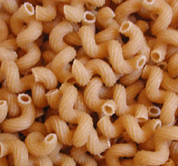Wheat
Updated: December 22, 2025

Wheat is Montana's leading cash crop. Montana is third among the wheat producing states in the U.S. Wheat is grown in nearly all the counties in Montana, on more than 8950 wheat farms. The largest grain producing area though, is the north central area of the state called the "Triangle Area."
There are many types of wheat grown in Montana. The primary type is hard red winter wheat. Other varieties include hard red spring wheat, soft white wheat and durum wheat. Montana's total wheat production has increased from 120 million bushels in 1974 to nearly 154 million bushels in 1999. This increase is due to better technology and utilization of the soil.
Hard wheats are used to make breads and rolls. The soft wheats are used in such goodies as cakes, pastries and crackers. Hard wheat or a combination of hard and soft wheats is blended to make all-purpose flour-most often used in homes for baking cakes and cookies. Durum, the hardest wheat of all, is used in pasta-macaroni, spaghetti, lasagna and more.

A wheat plant has four basic parts: head, stem, leaves and roots. The head is what contains the kernels. The stem supports the head, the leaves conduct photosynthesis and the roots hold the plant in the soil.
From planting to harvest, growing winter wheat is a year long process:
September:It's planting time for winter wheat. Wheat planting is called drilling. The seeds (grains of wheat) are planted with a "drill" pulled behind the tractor. Not all varieties of wheat are planted in the fall.
October:Wheat comes up as tiny sprouts that look like grass. It sprouts in the furrows, which are the lines the drill made during planting. It must sprout before the snow covers it, to prevent freezing.
November-February: The wheat is dormant during this period of time, which means it grows very slowly. The snow acts as a blanket to protect the wheat from the cold and wind.
March: The wheat begins to grow again at a normal rate. Planting of spring wheat begins.
April: Wheat is sprayed to protect it from weeds and insects.
June: By late June the wheat grain reaches the milk-stage. That means a white fluid can be squeezed out of the green kernel. This milk will turn into dough later and the kernel will turn from green to brown.

July-August: The wheat becomes dry and hardens. Now it's harvest time! Using a combine, the wheat plant is cut, and the seed (grain) is separated and cleaned. The combine is so named because it combines all the jobs into one. (Graphic above) It removes the wheat kernels from the plant and places them into a hopper. When the hopper is full,the wheat is unloaded into a truck, which is then driven to either a storage bin or a grain elevator.
Next, at the elevator, each load of wheat is sampled and graded for quality. The price a farmer gets for the wheat depends on its grade. The better the grade, the more money the farmer receives. From the elevator, the wheat may be sent by truck or train to a mill where it is ground to make flour for human foods. The type of flour produced depends upon what type of wheat it was made from. Or, the wheat may be sent to export facilities to be sent to overseas customers.
USDA Montana 2025 Wheat Varieties
Updated: December 22, 2025

